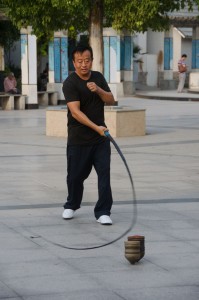Have a 4000 km trip to go to see Chinese tops players? Need to be sailed or well really addicted to embark on such a journey. Especially when you know nothing about the place where you can find these players. It’s a bit as if an Asian tourist was travelling in Provence to see petanque players. (If he is lucky and succeeds to be understood, people will indicate a village or a place where one plays this ‘sport’ but in practice, he has about as much chance as we finding petanque players.) Yet it is the journey we have undertaken with for only indication the name of a province in northern China; Henan province, to be precise.
After a 26 hours train ride, we therefore arrive in Zhengzhou, the capital of the province. I imagine that here, we just have to go walk in the city’s parks to discover players everywhere. The day after our arrival, we ask the hotel reception where we can see top players. The answer comes without hesitation; in the people’s Park, a large park located a few kilometres from the hotel. Time to pick up my bag with the gyro and the whip and here we go, for half-hour walk in the avenues of the city. At first glance, the aera is not very exciting but it is difficult to get an idea of the city which is four times larger than Paris, visiting a simple district.
In People Park
As all the parks in chinese cities, The people’s Park is overcrowdy on this summer day. But whether in Zhanjiang, Guangzhou or Zhengzhou, there are the same figures: small groups of students or school-boys who walk their eyes snapped to their smartphone’s screen, retirees installed on a bench playing cards or majhong, and the inevitable groups of middle-aged women exerted to dance or gymnastics on a background of music broadcasted by a weak loudspeaker. But no gyros players. We walk around the park, asking a few people who send us from one place to another, but without success. Until we find a group of retirees playing with large yoyos in a remote area of the Park. They are formal, there’s no gyro players in People Park. We need to go in a square which they tell us the name: “tomaguo”, or something similar. One of them even wrote the name of the place on the sand of their playground.
Back to the entrance of the Park, my wife checks the routes of the various buses which stop here, but without success. The name indicated by the yoyos players appears nowhere. While we are about to give up, my wife asked a girl waiting for the bus; She seems to know the place. We ship in the bus together and my wife questions the driver; we have the begining of a new track. The driver restarts and a few passengers mingle with the conversation. After a few minutes, all the people agree: of course, Tomaguo, is a small square overlooking East Street. Moreover, it is not Tomaguo but Dong men kou. You get off at the 6th stop and then you turn right in the avenue. You won’t be able to miss it.
Dong men kou’s gyros players
As usual, I understood nothing from the conversation but my wife did. And this time the indications appear to be accurate. We get off at the indicated stop, walk along the avenue on five hundred metres and there I heard the characteristic snapping of the whip’s tops players. Still a few tens of metres and we arrive at the entrance of the square at the bottom of which a handful of players are getting restless with their whip. They are only half a dozen but I have never seen as much (except on pictures). They ignore us until the moment I put my bag and pick up my top and my whip. Then, everyone freezes and looks at the foreigner that will launch its gyro. Fortunately, after 8 months of practice, I play not too badly and my first launch is correct. A few lashes later, other players of tops join us and begin to question my wife and then to inspect my top and my whip. Here as in Zhanjiang, it is a small informal group; retirees for most which gather every day at the square to practice their favourite activity. Among them, there is the specialist who quickly gives its verdict: my gyro is like this like that, too light. As for the whip, it is too long and the lash who finishs it is too thick.
I could tell him that it is a handcrafted gyro made by my uncle Souzai, that I have others heavier at home and that I chose the lightest for our trip. I say nothing; I am used to this kind of remarks. Already in Zhanjiang, a few players who practice in the Park had criticized my first gyro and my first whip. But I finally understood that in this domain everyone has his own preferences and in every city there are different habits. Finally, it is a bit like petanque; some prefer heavy balls, others those that are ribbed. Regardless, I leave specialist tinkering my whip that he extends of about 30 centimetres by adding a finer string. During this time, I took the opportunity to try the whip of another player, homemade with old bicycle inner tubes, and test other gyros in different shapes including one in gourd shaped that defies the laws of balance.
An hour later, we leave promising them to return in four days when we will be back from Kaifeng. Indeed, the next day we go visit this small town (of 5 million inhabitants), located one hour by train from Zhengzhou where there are, it seems, many tops players.
